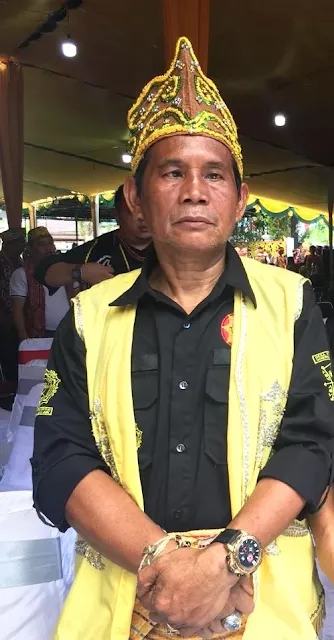The Enduring Dayak Kingdom of Ulu Ai, Ketapang, West Borneo
 |
| Patih Singa Bansa, King Ulu Ai LI (51st). Doc. the researcher. |
If you ever get the chance to visit West Kalimantan, go to Ketapang. There, in a remote area, you'll find a kingdom that was established in the 17th century and still exists today, known as the Hulu Aik Kingdom (Ulu Ai).
This is one of the oldest royal sites in western Borneo, revealing many historical facts that you should know.
A lineage that firmly establishes historical facts beyond dispute. The succession from one monarch to the next, an unbroken chain akin to the papacy, tracing from St. Peter to Pope Francis, spans from the first to the 266th Pope.
Such is the Kingdom of Ulu Ai in West Kalimantan. Among the oldest kingdoms in the Indonesian archipelago, it traces its lineage from King I (Patih Bihuk Tiung, King Ulu Aik) to its current 51st monarch, Petrus Singa Bansa.
The enduring Dayak Kingdom of Ulu Ai
Royalty. In this millennium era, do they still exist? Perhaps only in England. Or on certain blue continents and in the Middle East, where kingdoms may still persist.
Yet, particularly in the Indonesian archipelago, that era has passed. With the advent of Indonesian independence, kingdoms throughout the archipelago have since dissolved, submitting under new forms of governance.
 | ||||
|
Proof of local kingship, whether here or there, is evidenced by the legacy left by their predecessors. Post-kingdom and sultanate eras, their lands and territories stand as testament.
Take for instance the Sultanate of Yogyakarta. Their lands are under the authority of the Sultan. Evidence that a kingdom possesses not only its people but also land and territory.
In Borneo, nearly all sultanates and kingdoms had only their people. Once the Indonesian archipelago gained independence, their people's sultanates and kingdoms disappeared. Only the palaces remained. Only buildings and museums. Kingdoms and sultanates did not have lands and territories.
Not so with the Kingdom of Ulu Ai, where now their lands and territories—and their monarch—reside in the region of Ketapang, West Kalimantan. From a genealogical perspective, we can also list their successive monarchs.
This is a historical inevitability. No need for lamentation. Nevertheless, this does not mean that the past era has completely vanished. Take, for example, the Ulu Ai Kingdom, which continues to exist to this day. Its echoes grow even louder.
Who listens to them? The gong resonates from within.
The Kingdom of Ulu Ai was established around the 1700s
As is known, the Kingdom of Ulu Ai is located in Kalimantan, Ketapang Regency, West Kalimantan province. The Kingdom of Ulu Ai was established around the 1700s.
According to accounts from witnesses and historical figures, the Kingdom of Ulu Ai is an ancient Tanjungpura kingdom, founded around 800 AD by Maniaka (known in Indonesian history as Sang Maniaka), centered in Pancur Sambore and Tanjung Porikng, upstream of the Krio River, Ketapang, West Kalimantan (now Desa Benua Krio, Kec. Hulu Sungai, Kab. Ketapang).
The Keris Bosi Koling Tungkat Rakyat is believed to be a dagger used and entrusted by Mahapatih Gajah Mada of the Majapahit Kingdom to the Kingdom of Ulu Ai.
Legend has it that one of Maniaka's sons, Siak Bahulun, titled Todong Rusi, was a fierce and ruthless Dayak warrior against his enemies.
The kingdom's territory, as recorded in the Javanese historical text, Kitab Negarakertagama by Mpu Prapanca, included areas known as Labai Lawai, or Laman Sembilan Domong Sepuluh (now comprising Pantai-Darat Kapuas, upstream Kapuas, upstream Landak, Sanggau, Jelai-Kendawangan, Pesaguan, Kayong-Gerunggang, Jokak-Laur, Bihak-Krio, and Central Kalimantan).
In the 17th century, the influence of Islam in the coastal areas of Kalimantan, following the collapse of the Majapahit Kingdom, caused the kingdom's nobility to split.
Some decided to move to the mouth of the Pawan River under the leadership of Giri Kusuma, while others remained in the upstream Krio River under the leadership of Ukir. At the mouth of the Pawan River, Giri Kusuma established a new kingdom called the Kingdom of Matan Tanjungpura.
Meanwhile, Ukir remained in the upstream Krio River and managed the Ulu Ai palace. He later became the king with the title Patih Empu Geremeng.
Historical research and witnesses
Through historical research and witnesses, we know the kings of Ulu Ai after Patih Empu Geremeng:
1. Patih Bihuk Tiung, King Ulu Ai I,
2. Patih Bansa Pati, King Ulu Ai II,
3. Patih Ira Bansa, King Ulu Ai III,
4. Patih Jambu, King Ulu Ai IV,
5. Patih Bebek, King Ulu Ai V,
Patih Singa Bansa, King Ulu Ai LI (51st) until now, with the kingdom's palace located in Kampung Sengkuang, Desa Benua Krio, Kec. Hulu Sungai, Kab. Ketapang).
Patih Singa Bansa, King Ulu Ai LI
Patih Singa Bansa, King Ulu Ai LI, is married to Anastasia Bijan. Together, they are blessed with a son named Edi Kurniawan. This family lives harmoniously, peacefully, and in unity with both local and non-local communities.
Remnants of heirlooms from the past still have many tales to tell. In the kingdom's palace, artifacts belonging to the kingdom are stored, such as the Keris Bosi Koling Tungkat Rakyat, a 20 cm long yellow iron dagger.
The Keris Bosi Koling Tungkat Rakyat is believed to have been used and entrusted by Mahapatih Gajah Mada of the Majapahit Kingdom to the Kingdom of Ulu Ai.
There are many other relics in this palace, which are ritually bathed by the king and his family during the Meruba Ceremony held on June 25th every year.
Writer: Rangkaya Bada
Researcher: Masri Sareb Putra, M.A.





